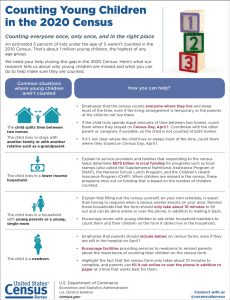Census Hopes to Reverse Decades of Under-counting Youngest Children
The US Census is so important that the Constitution requires it. Since 1790, the nation has counted its people every 10 years. The data gathered touch all of us: they determine the number of representatives our state has in congress; they’re used in the creation of legislative and school districts; they even affect how states and communities distribute funding for things like neighborhood improvements, public health, and education.
But one group has consistently been overlooked for decades. The US Census Bureau says that young children – ages zero to four – are often missed. As many as one in every 10 young children was left out of the 2010 census, according to the non-profit Population Reference Bureau. PRB says these youngest people are more likely to be overlooked than any other age group.
The Bureau says children who are most likely to be under-counted tend to fall one or more of several categories:
- They’re often not a biological or adopted child of the householder. This may include kids who live with a grandparent or other relative who is not their parent
- They live in rental or multi-unit structures
- These children are often Hispanic or racial minorities
- They are from “complex” households, defined as all households other than nuclear families (often single-parent or single-person household)
- Some are born or moved just before data are collected
Why they’re missed is more difficult to pin down, but the Bureau lists some common situations. For example, young children may live with young mothers who are also overlooked; some children live in “hard to count” households; in some cases, entire households or housing units have been overlooked. Language is also a factor. PRB says households that are “linguistically isolated” are more likely to be missed.
The Bureau is aware of the problem. In 2015, it created a research group called Undercount of Young Children Research Team in hopes of mitigating the problem in 2020. Here are some changes for 2020 that they hope will help:
- Rewording of Bureau materials. Census materials more explicitly explain that everyone should be counted, “to reinforce the idea that the census counts everyone in the household, regardless of age or relationship to the householder.”
- Materials used to train the counters in the field specifically mention the need to include all children. This includes both online and in-class training modules.
- Public education and outreach. The Bureau is partnering with external groups to help spread the word; these include the National Advisory Committee, the Partnership for America’s Children, and the Census Information Centers. It is also working on its own outreach materials, including this infographic.
These children are often part of under-served communities and can’t speak up for themselves. Younger children are more likely than older children to live in poverty, receive public assistance, or to live with a parent who is unemployed. When these children aren’t counted in the census, they and their communities miss out on opportunities afforded to everyone else.
What insights do you have? The Bureau is hoping to gather more accurate data, but admits that this is a difficult problem to solve. What would you do differently?
The post Census Hopes to Reverse Decades of Under-counting Youngest Children appeared first on Community Engagement Learning Exchange.



